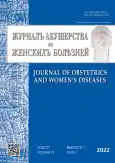HLA-G基因及其表达在习惯性流产发生中的作用
- 作者: Bakleycheva M.O.1, Bespalova O.N.1, Ivashchenko T.E.1
-
隶属关系:
- The Research Institute of Obstetrics, Gynecology and Reproductology named after D.O. Ott
- 期: 卷 71, 编号 1 (2022)
- 页面: 101-108
- 栏目: Reviews
- URL: https://bakhtiniada.ru/jowd/article/view/76384
- DOI: https://doi.org/10.17816/JOWD76384
- ID: 76384
如何引用文章
详细
总结了国内外现代临床研究的结果,介绍了主要组织相容性复合体(HLA)分子和非经典HLA-G分子在滋养细胞上表达的重要性,特别是在妊娠早期的生理过程中的信息。HLA-G基因在抗原处理和表达方面具有核心功能,并抑制自然杀伤细胞受体,导致母胎界面的免疫反应减少,并为胎儿提供母体免疫耐受。它的表达取决于转录因子、微RNA和环境因素的组合。在此基础上,进行了100多项实验研究,研究HLA-G基因的表达,并证明其对妊娠并发症的发生,如早期习惯性流产的影响,免疫学因素被认为在其中起着关键作用。
作者简介
Margarita O. Bakleycheva
The Research Institute of Obstetrics, Gynecology and Reproductology named after D.O. Ott
Email: bakleicheva@gmail.com
ORCID iD: 0000-0002-0103-8583
Scopus 作者 ID: 57203248029
MD, junior research schientist of Department of obstetrics and perinatology
俄罗斯联邦, 3, Mendeleevskaya Line, Saint Petersburg, 199034Olesya N. Bespalova
The Research Institute of Obstetrics, Gynecology and Reproductology named after D.O. Ott
Email: shiggerra@mail.ru
ORCID iD: 0000-0002-6542-5953
SPIN 代码: 4732-8089
MD, Dr. Sci. (Med.)
俄罗斯联邦, 3, Mendeleevskaya Line, Saint Petersburg, 199034Tatyana E. Ivashchenko
The Research Institute of Obstetrics, Gynecology and Reproductology named after D.O. Ott
编辑信件的主要联系方式.
Email: tivashchenko2011@mail.ru
ORCID iD: 0000-0002-8549-6505
PhD, Dr. Sci. (Biol.), Professor
俄罗斯联邦, 3, Mendeleevskaya Line, Saint Petersburg, 199034参考
- Djurisic S, Hviid TV. HLA Class Ib molecules and immune cells in pregnancy and preeclampsia. Front Immunol. 2014;5:652. doi: 10.3389/fimmu.2014.00652
- Bakleicheva MO, Bespalova ON, Ivashchenko TE. Role of class I HLA (G, E, and C) expression in early reproductive losses. Obstetrics and Gynecology. 2020;(2):30−36. (In Russ.). doi: 10.18565/aig.2020.2.30-36
- Carosella ED, Ploussard G, LeMaoult J, Desgrandchamps F. A systematic review of immunotherapy in urologic cancer: Evolving roles for targeting of CTLA-PD-1/PD-L1, and HLA-G. Eur Urol. 2015;68(2):267−279. doi: 10.1016/j.eururo.2015.02.032
- Szekeres-Bartho J, Markert UR, Varla-Leftherioti M. Immunology in reproduction. J Reprod Immunol. 2015;108:1. doi: 10.1016/j.jri.2015.03.003
- de Wynter EA, Testa NG. Interest of cord blood stem cells. Biomed Pharmacother. 2001;55(4):195−200. doi: 10.1016/s0753-3322(01)00049-x
- Serova LD. Immunologicheskij HLA-status u zhenshhin s privychnym nevynashivaniem beremennosti: metodicheskie rekomendacii. Moscow, 1998. (In Russ.)
- Steinbrook R. The cord-blood-bank controversies. N Engl J Med. 2004;351(22):2255−2257. doi: 10.1056/NEJMp048283
- Ferreira LMR, Meissner TB, Tilburgs T, Strominger JL. HLA-G: At the interface of maternal-fetal tolerance. Trends Immunol. 2017;38:272–286. doi: 10.1016/j.it.2017.01.009
- Choudhury SR, Knapp LA. Human reproductive failure II: immunogenetic and interacting factors. Hum Reprod Update. 2001;7(2):135−160. doi: 10.1093/humupd/7.2.135
- Lorentzen DF, Iwanaga KK, Meuer KJ, et al. A 25% error rate in serologic typing of HLA-B homozygotes. Tissue Antigens. 1997;50(4):359−365. doi: 10.1111/j.1399-0039.1997.tb02888.x
- Komlos L, Zamir R, Joshua H, Halbrecht I. Common HLA antigens in couples with repeated abortions. Clin Immunol Immunopathol. 1977;7(3):330−335. doi: 10.1016/0090-1229(77)90066-6
- Christiansen OB, Ring M, Rosgaard A, et al. Association between HLA-DR1 and -DR3 antigens and unexplained repeated miscarriage. Hum Reprod Update. 1999;5(3):249−255. doi: 10.1093/humupd/5.3.249
- Dahl M, Klitkou L, Christiansen OB, et al. Human leukocyte antigen (HLA)-G during pregnancy part II: associations between maternal and fetal HLA-G genotypes and soluble HLA-G. Hum Immunol. 2015;76(4):260−271. doi: 10.1016/j.humimm.2015.01.015
- Plaks V, Rinkenberger J, Dai J, et al. Matrix metalloproteinase-9 deficiency phenocopies features of preeclampsia and intrauterine growth restriction. Proc Natl Acad Sci USA. 2013;110(27):11109−11114. doi: 10.1073/pnas.1309561110
- Zidi I, Rizzo R, Bouaziz A, et al. sHLA-G1 and HLA-G5 levels are decreased in Tunisian women with multiple abortion. Hum Immunol. 2016;77:342–345. doi: 10.1016/j.humimm.2016.01.019
- Ikeno M, Suzuki N, Kamiya M, et al. LINE1 family member is negative regulator of HLA-G expression. Nucleic Acids Res. 2012;40(21):10742−10752. doi: 10.1093/nar/gks874
- Bespalova O, Bakleicheva M, Ivashchenko T, et al. Expression of HLA-G and KIR2DL4 receptor in chorionic villous in missed abortion. Gynecol Endocrinol. 2020;36(Supp1):43−47. doi: 10.1080/09513590.2020.1816716
- Akhter A, Das V, Naik S, et al. Upregulation of HLA-G in JEG-3 cells by dexamethasone and hydrocortisone. Arch Gynecol Obstet. 2012;285(1):7−14. doi: 10.1007/s00404-011-1880-3
- Barrientos G, Toro A, Moschansky P, et al. Leptin promotes HLA-G expression on placental trophoblasts via the MEK/Erk and PI3K signaling pathways. Placenta. 2015;36(4):419−426. doi: 10.1016/j.placenta.2015.01.006
- Gregori S, Amodio G, Quattrone F, Panina-Bordignon P. HLA-G Orchestrates the early interaction of human trophoblasts with the maternal niche. Front Immunol. 2015;6:128. doi: 10.3389/fimmu.2015. 00128
- Wang X, Li B, Wang J, et al. Evidence that miR-133a causes recurrent spontaneous abortion by reducing HLA-G expression. Reprod Biomed Online. 2012;25(4):415−424. doi: 10.1016/j.rbmo.2012.06.022
- Wu ZS, Wang CQ, Xiang R, et al. Loss of miR-133a expression associated with poor survival of breast cancer and restoration of miR-133a expression inhibited breast cancer cell growth and invasion. BMC Cancer. 2012;12:51. doi: 10.1186/1471-2407-12-51
- Guo W, Fang L, Li B, et al. Decreased human leukocyte antigen-G expression by miR-133a contributes to impairment of proinvasion and proangiogenesis functions of decidual NK cells. Front Immunol. 2017;8:741. doi: 10.3389/fimmu.2017.00741
- Rokhafrooz S, Ghadiri A, Ghandil P, et al. Association between HLA-G 14bp gene polymorphism and serum sHLA-G protein concentrations in preeclamptic patients and normal pregnant women. Immunol Invest. 2018;47:558–568. doi: 10.1080/08820139.2018.1467925
- Alenichev AS, Nasyhova JuA, Ivashhenko EJe, Baranov VS. Harakteristika geneticheskoj struktury populjacii Severo-Zapadnogo regiona RF po genu HLA-G. Jekologicheskaja genetika. 2014;12(2):74−80. (In Russ.)
补充文件










